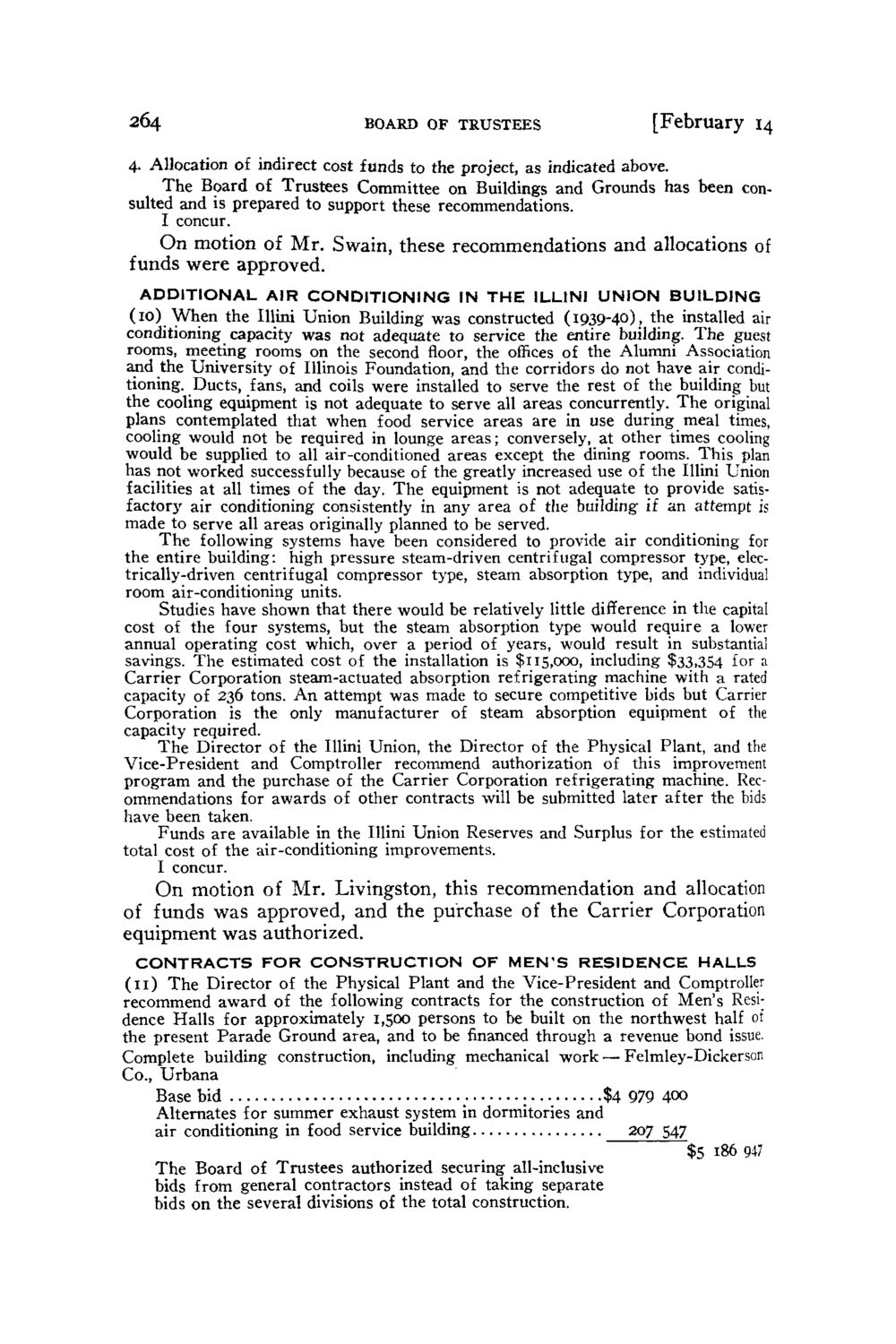| |
| |
Caption: Board of Trustees Minutes - 1958
This is a reduced-resolution page image for fast online browsing.

EXTRACTED TEXT FROM PAGE:
264 BOARD OF TRUSTEES [February 14 4. Allocation of indirect cost funds to the project, as indicated above. The Board of Trustees Committee on Buildings and Grounds has been consulted and is prepared to support these recommendations. I concur. O n m o t i o n of M r . S w a i n , t h e s e r e c o m m e n d a t i o n s a n d a l l o c a t i o n s of funds were approved. ADDITIONAL AIR CONDITIONING IN THE ILLINI UNION BUILDING (10) When the Mini Union Building was constructed (1939-40), the installed air conditioning capacity was not adequate to service the entire building. The guest rooms, meeting rooms on the second floor, the offices of the Alumni Association and the University of Illinois Foundation, and the corridors do not have air conditioning. Ducts, fans, and coils were installed to serve the rest of the building but the cooling equipment is not adequate to serve all areas concurrently. The original plans contemplated that when food service areas are in use during meal times, cooling would not be required in lounge areas; conversely, at other times cooling would be supplied to all air-conditioned areas except the dining rooms. This plan has not worked successfully because of the greatly increased use of the Mini Union facilities at all times of the day. The equipment is not adequate to provide satisfactory air conditioning consistently in any area of the building if an attempt is made to serve all areas originally planned to be served. T h e following systems have been considered to provide air conditioning for the entire building: high pressure steam-driven centrifugal compressor type, electrically-driven centrifugal compressor type, steam absorption type, and individual room air-conditioning units. Studies have shown that there would be relatively little difference in the capital cost of the four systems, but the steam absorption type would require a lower annual operating cost which, over a period of years, would result in substantial savings. The estimated cost of the installation is $115,000, including $33,354 for a Carrier Corporation steam-actuated absorption refrigerating machine with a rated capacity of 236 tons. An attempt was made to secure competitive bids but Carrier Corporation is the only manufacturer of steam absorption equipment of the capacity required. T h e Director of the Mini Union, the Director of the Physical Plant, and the Vice-President and Comptroller recommend authorization of this improvement program and the purchase of the Carrier Corporation refrigerating machine. Recommendations for awards of other contracts will be submitted later after the bids have been taken. Funds are available in the Mini Union Reserves and Surplus for the estimated total cost of the air-conditioning improvements. I concur. On motion of Mr. Livingston, this recommendation and allocation of funds was approved, and the purchase of the Carrier Corporation equipment was authorized. C O N T R A C T S F O R C O N S T R U C T I O N O F M E N ' S R E S I D E N C E HALLS (11) The Director of the Physical Plant and the Vice-President and Comptroller recommend award of the following contracts for the construction of Men's Resi; dence Halls for approximately 1,500 persons to be built on the northwest half of the present Parade Ground area, and to be financed through a revenue bond issue. Complete building construction, including mechanical work — Felmley-Dickerson Co., Urbana Base bid $4 979 400 Alternates for summer exhaust system in dormitories and air conditioning in food service building 207 547 $5 186 947 T h e Board of Trustees authorized securing all-inclusive bids from general contractors instead of taking separate bids on the several divisions of the total construction.
| |